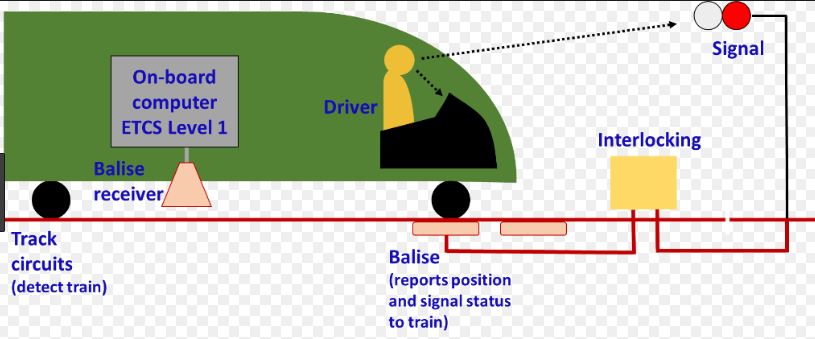UPDATE: New November 22, 2017 News:
GO is going to deploy ETCCS -- Enhanced Train Control and Conventional Signaling:
Parsons secures Metrolinx ETCS Contract
This is a hybrid between
European ETCS and traditional railroad signalling. It has a moving-block upgrade path. ETCS Level 3 is equivalent to CBTC with moving-block ability. This means Metrolinx/GO is currently deploying a signal system upgrade path that keeps the door open to moving-block capabilities found in ultra-short-headway metro systems.
UPDATE: Post updated April 2016:
Hello,
GLOSSARY:
PTC = Positive Train Control
CBTC = Communications-Based Train Control (can also do positive train control safety responsibilities too).
ATC = Automatic Train Control, often piggybacked on PTC or CBTC
CBTC (or a variant) is now part of Metrolinx requirement for GO RER
Positive train control does an automatic slowdown/stop of your train for safety if train tries to exceed speed limit for any reason (grade, error, inattention, traffic) and/or if it detects known danger ahead (such as a train ahead, a curve ahead, TSOs, PSOs). This saves everybody's asses when the train driver does not manually slow down the train on time for any reason.
Shorter Headways
These requires more advanced control systems. All major RER systems worldwide with tight headways (e.g. 3-minute, 5-minute) now use an enhanced control system such as PTC or CBTC or an Europe variant called ECTS. Paris RER, German S-Bahn, all use variants of these systems. The GO $13.5bn electrification budget includes the cost of this upgrade. Such systems are particularly important for the "SmartTrack" route of GO RER, which may have the tightest headways on the GO network.
TTC Uses It
TTC already has been using a PTC variant for a long time. They are upgrading to CBTC to allow ~2-minute headways on Yonge. The addition of the system to GO's system is one of the pieces necessary to make GO feel more like a metro system, similar to other RER/RER-like systems worldwide.
GO already is researching 5-minute headways on some RER routes (like the "SmartTrack" routing)
Several Metrolinx documents mentions 5-minute headways on some RER routes (like the SmartTrack route). While there is a lot of debate whether or not this is possible with the first $13.5bn of GO RER, there is definitely no doubt given sufficient money, a CBTC system makes this path possible as has already occured elsewhere in the world.
How much is PTC or CBTC?
The assumed cost of installing CBTC into the GO network is estimated by Metrolinx to be $800 million, embedded as part of the existing $13.5bn GO RER/electrification budget. PTC is estimated only $200 million, but Metrolinx is planning on going beyond and planning CBTC for RER.
Saves Lives / Amtrak Disaster
With the Amtrak disaster, and the fact that positive train control would have prevented deaths:
www.npr.org/sections/thetwo-way/2015/05/14/406652406/positive-train-control-the-tech-that-couldve-prevented-amtrak-derailment
www.cnn.com/2015/05/15/us/philadelphia-amtrak-train-derailment/
The train and track was equipped with this safety system, but wasn't turned on yet because they hadn't yet gotten permission to turn on the train control radios yet (radio frequency permission issue)!
Automatic Train Control?
This is often an optional feature of advanced train control systems (variants of PTC and CBTC). GO will not use this unsupervied due to unions and safety issues, especially given platform overcrowding, but the technology provides that option for some systems worldwide. In reality, automation is
like an autopilot, which the train driver supervises. This is a speed optimizer, to keep a train more easily in its headway between trains, accelerating and decelerating precisely.
Union Station Bottleneck?
Recent 2015-2016 Metrolinx documents mention other planned major upgrades (Union Station Rail Corridor) plan to increase train throughput at Union station to approximately 50 trains per hour (by ~2031). This includes 45mph crossovers in the east and 30mph crossovers in the west. With this speed and signalling upgrades made available, combined with CBTC, trains will no longer need to crawl slowly towards Union for several minutes before entering the beginning of a Union platform. Combined with short-dwelling, and (potentially expensive) optimizations elsewhere, this potentially allows at least one combined route to have approximately 5-minute same-platform headways at Union, presumably on one of the wider platforms. Whether the debate of ultimate headways are 15-minute or 5-minute, it is assumed that headways will progressively decrease as upgrades are rolled out, and will likely further continue beyond the initial completion from the $13.5bn GO RER budget.
GO RER requires CBTC -- See Newer Post
The short headways in GO RER objectives require very tight train headways. During frequent train services, this can mean increased risks and safety issues (collisions, etc). CBTC will help greatly permitting trains to follow trains at braking distances. TTC, and many other frequent-service subways, already has positive train control on their subway train for a very long time now, and are upgrading to CBTC.
How urgently should positive train control / communications based train control arrive on GO's network? Let's discuss.





